child restraint Lancia Ypsilon 2002 Owner handbook (in English)
[x] Cancel search | Manufacturer: LANCIA, Model Year: 2002, Model line: Ypsilon, Model: Lancia Ypsilon 2002Pages: 191, PDF Size: 2.45 MB
Page 29 of 191
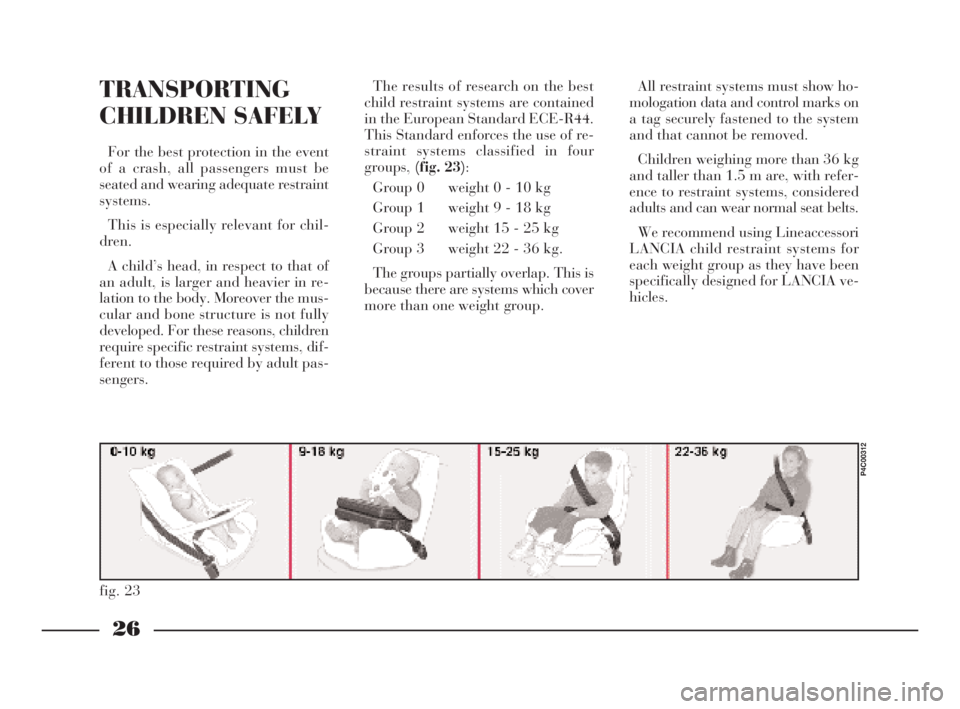
26
G
fig. 23
P4C00312
TRANSPORTING
CHILDREN SAFELY
For the best protection in the event
of a crash, all passengers must be
seated and wearing adequate restraint
systems.
This is especially relevant for chil-
dren.
A child’s head, in respect to that of
an adult, is larger and heavier in re-
lation to the body. Moreover the mus-
cular and bone structure is not fully
developed. For these reasons, children
require specific restraint systems, dif-
ferent to those required by adult pas-
sengers.The results of research on the best
child restraint systems are contained
in the European Standard ECE-R44.
This Standard enforces the use of re-
straint systems classified in four
groups,(fig. 23):
Group 0 weight 0 - 10 kg
Group 1 weight 9 - 18 kg
Group 2 weight 15 - 25 kg
Group 3 weight 22 - 36 kg.
The groups partially overlap. This is
because there are systems which cover
more than one weight group.All restraint systems must show ho-
mologation data and control marks on
a tag securely fastened to the system
and that cannot be removed.
Children weighing more than 36 kg
and taller than 1.5 m are, with refer-
ence to restraint systems, considered
adults and can wear normal seat belts.
We recommend using Lineaccessori
LANCIA child restraint systems for
each weight group as they have been
specifically designed for LANCIA ve-
hicles.
4C001-067 ING 11-03-2008 11:57 Pagina 26
Page 30 of 191
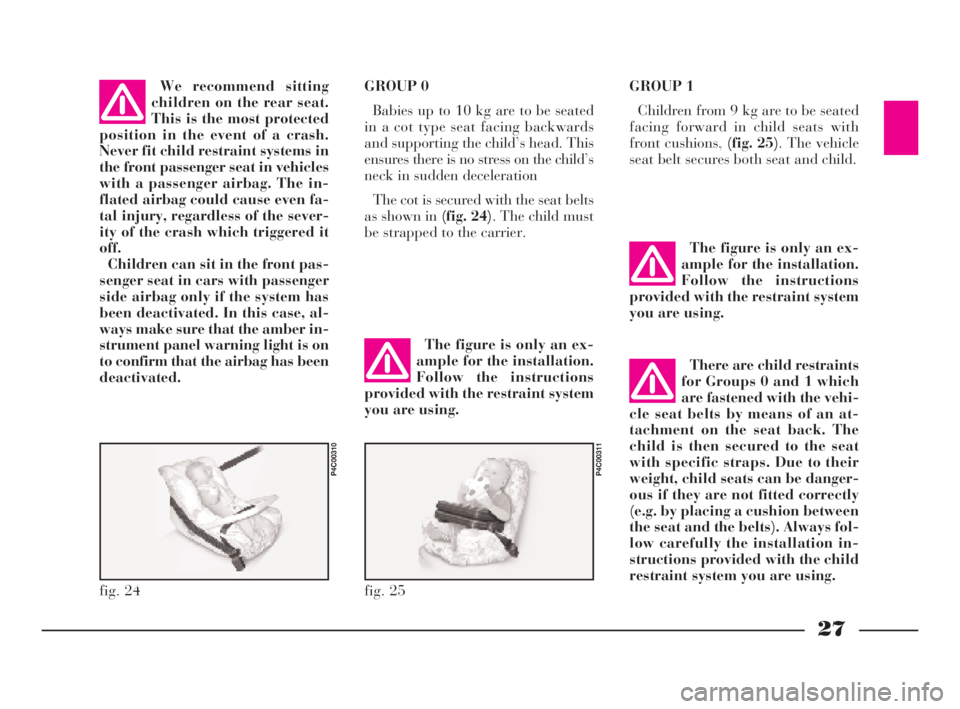
27
G
fig. 24
P4C00310
fig. 25
P4C00311
We recommend sitting
children on the rear seat.
This is the most protected
position in the event of a crash.
Never fit child restraint systems in
the front passenger seat in vehicles
with a passenger airbag. The in-
flated airbag could cause even fa-
tal injury, regardless of the sever-
ity of the crash which triggered it
off.
Children can sit in the front pas-
senger seat in cars with passenger
side airbag only if the system has
been deactivated. In this case, al-
ways make sure that the amber in-
strument panel warning light is on
to confirm that the airbag has been
deactivated.GROUP 0
Babies up to 10 kg are to be seated
in a cot type seat facing backwards
and supporting the child’s head. This
ensures there is no stress on the child’s
neck in sudden deceleration
The cot is secured with the seat belts
as shown in (fig. 24). The child must
be strapped to the carrier.GROUP 1
Children from 9 kg are to be seated
facing forward in child seats with
front cushions, (fig. 25). The vehicle
seat belt secures both seat and child.
The figure is only an ex-
ample for the installation.
Follow the instructions
provided with the restraint system
you are using.
The figure is only an ex-
ample for the installation.
Follow the instructions
provided with the restraint system
you are using.
There are child restraints
for Groups 0 and 1 which
are fastened with the vehi-
cle seat belts by means of an at-
tachment on the seat back. The
child is then secured to the seat
with specific straps. Due to their
weight, child seats can be danger-
ous if they are not fitted correctly
(e.g. by placing a cushion between
the seat and the belts). Always fol-
low carefully the installation in-
structions provided with the child
restraint system you are using.
4C001-067 ING 11-03-2008 11:57 Pagina 27
Page 31 of 191
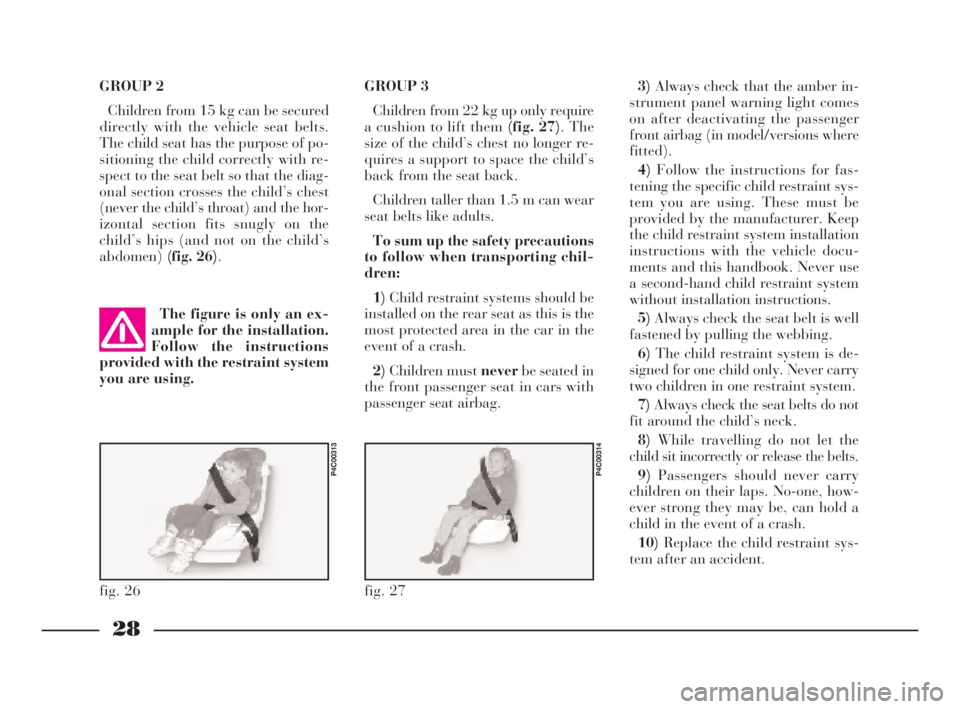
28
G
fig. 26
P4C00313
fig. 27
P4C00314
GROUP 2
Children from 15 kg can be secured
directly with the vehicle seat belts.
The child seat has the purpose of po-
sitioning the child correctly with re-
spect to the seat belt so that the diag-
onal section crosses the child’s chest
(never the child’s throat) and the hor-
izontal section fits snugly on the
child’s hips (and not on the child’s
abdomen)(fig. 26).GROUP 3
Children from 22 kg up only require
a cushion to lift them (fig. 27). The
size of the child’s chest no longer re-
quires a support to space the child’s
back from the seat back.
Children taller than 1.5 m can wear
seat belts like adults.
To sum up the safety precautions
to follow when transporting chil-
dren:
1)Child restraint systems should be
installed on the rear seat as this is the
most protected area in the car in the
event of a crash.
2)Children must neverbe seated in
the front passenger seat in cars with
passenger seat airbag.3)Always check that the amber in-
strument panel warning light comes
on after deactivating the passenger
front airbag (in model/versions where
fitted).
4)Follow the instructions for fas-
tening the specific child restraint sys-
tem you are using. These must be
provided by the manufacturer. Keep
the child restraint system installation
instructions with the vehicle docu-
ments and this handbook. Never use
a second-hand child restraint system
without installation instructions.
5)Always check the seat belt is well
fastened by pulling the webbing.
6)The child restraint system is de-
signed for one child only. Never carry
two children in one restraint system.
7)Always check the seat belts do not
fit around the child’s neck.
8)While travelling do not let the
child sit incorrectly or release the belts.
9)Passengers should never carry
children on their laps. No-one, how-
ever strong they may be, can hold a
child in the event of a crash.
10)Replace the child restraint sys-
tem after an accident. The figure is only an ex-
ample for the installation.
Follow the instructions
provided with the restraint system
you are using.
4C001-067 ING 11-03-2008 11:57 Pagina 28
Page 63 of 191
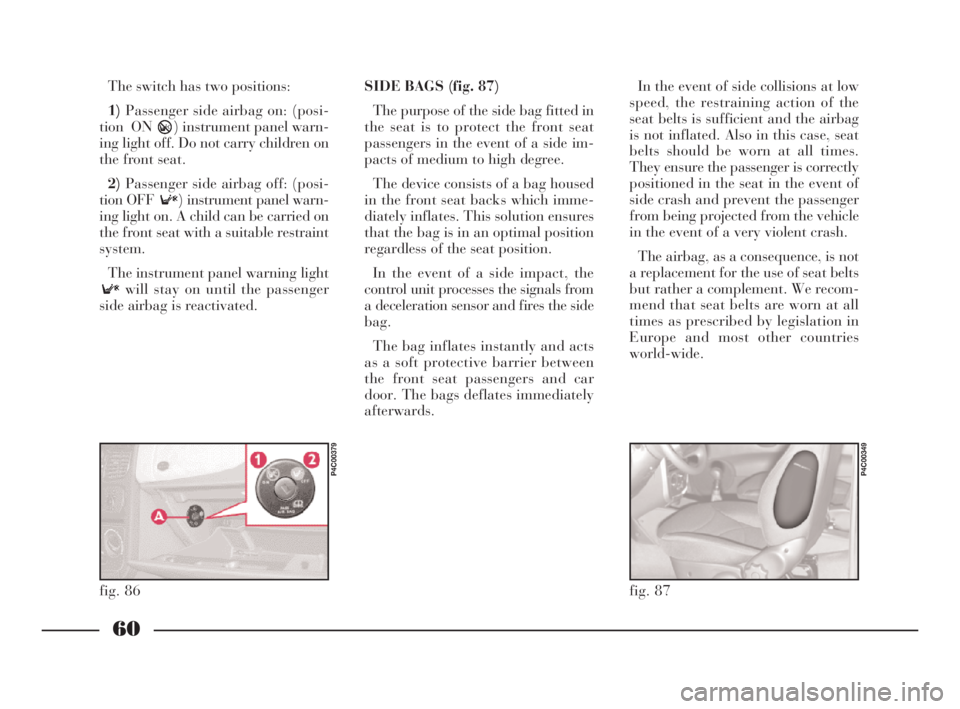
60
G
The switch has two positions:
1)Passenger side airbag on: (posi-
tion ON ) instrument panel warn-
ing light off. Do not carry children on
the front seat.
2)Passenger side airbag off: (posi-
tion OFF ) instrument panel warn-
ing light on. A child can be carried on
the front seat with a suitable restraint
system.
The instrument panel warning light
will stay on until the passenger
side airbag is reactivated. SIDE BAGS (fig. 87)
The purpose of the side bag fitted in
the seat is to protect the front seat
passengers in the event of a side im-
pacts of medium to high degree.
The device consists of a bag housed
in the front seat backs which imme-
diately inflates. This solution ensures
that the bag is in an optimal position
regardless of the seat position.
In the event of a side impact, the
control unit processes the signals from
a deceleration sensor and fires the side
bag.
The bag inflates instantly and acts
as a soft protective barrier between
the front seat passengers and car
door. The bags deflates immediately
afterwards.In the event of side collisions at low
speed, the restraining action of the
seat belts is sufficient and the airbag
is not inflated. Also in this case, seat
belts should be worn at all times.
They ensure the passenger is correctly
positioned in the seat in the event of
side crash and prevent the passenger
from being projected from the vehicle
in the event of a very violent crash.
The airbag, as a consequence, is not
a replacement for the use of seat belts
but rather a complement. We recom-
mend that seat belts are worn at all
times as prescribed by legislation in
Europe and most other countries
world-wide.
fig. 86
P4C00379
fig. 87
P4C00349
4C001-067 ING 11-03-2008 11:57 Pagina 60
Page 65 of 191
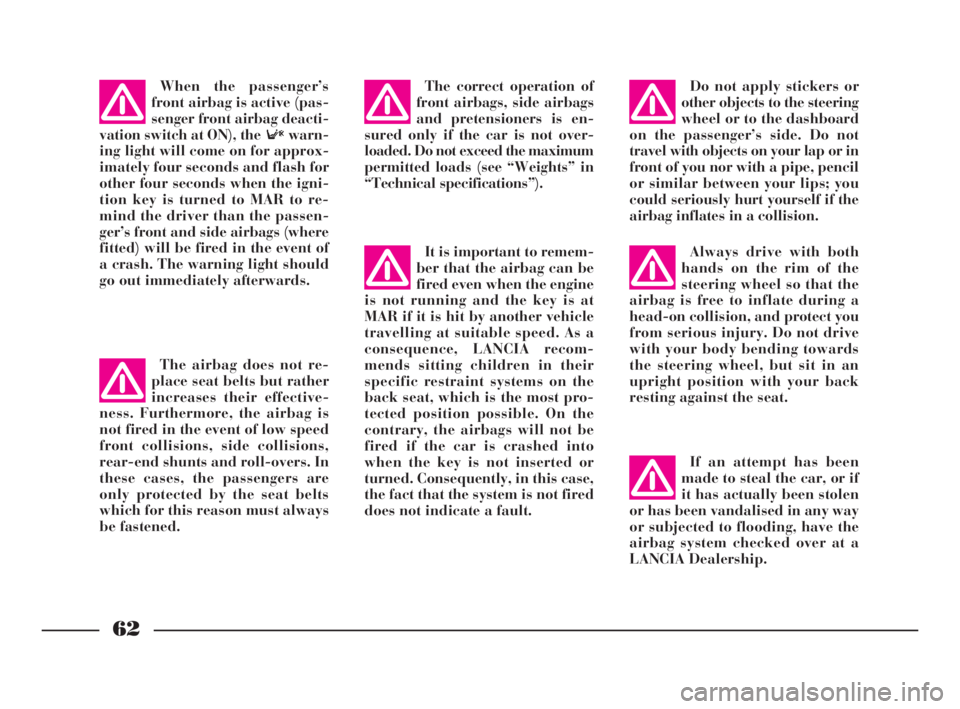
62
G
It is important to remem-
ber that the airbag can be
fired even when the engine
is not running and the key is at
MAR if it is hit by another vehicle
travelling at suitable speed. As a
consequence, LANCIA recom-
mends sitting children in their
specific restraint systems on the
back seat, which is the most pro-
tected position possible. On the
contrary, the airbags will not be
fired if the car is crashed into
when the key is not inserted or
turned. Consequently, in this case,
the fact that the system is not fired
does not indicate a fault.Always drive with both
hands on the rim of the
steering wheel so that the
airbag is free to inflate during a
head-on collision, and protect you
from serious injury. Do not drive
with your body bending towards
the steering wheel, but sit in an
upright position with your back
resting against the seat.
If an attempt has been
made to steal the car, or if
it has actually been stolen
or has been vandalised in any way
or subjected to flooding, have the
airbag system checked over at a
LANCIA Dealership. Do not apply stickers or
other objects to the steering
wheel or to the dashboard
on the passenger’s side. Do not
travel with objects on your lap or in
front of you nor with a pipe, pencil
or similar between your lips; you
could seriously hurt yourself if the
airbag inflates in a collision.
The correct operation of
front airbags, side airbags
and pretensioners is en-
sured only if the car is not over-
loaded. Do not exceed the maximum
permitted loads (see “Weights” in
“Technical specifications”).When the passenger’s
front airbag is active (pas-
senger front airbag deacti-
vation switch at ON), the warn-
ing light will come on for approx-
imately four seconds and flash for
other four seconds when the igni-
tion key is turned to MAR to re-
mind the driver than the passen-
ger’s front and side airbags (where
fitted) will be fired in the event of
a crash. The warning light should
go out immediately afterwards.
The airbag does not re-
place seat belts but rather
increases their effective-
ness. Furthermore, the airbag is
not fired in the event of low speed
front collisions, side collisions,
rear-end shunts and roll-overs. In
these cases, the passengers are
only protected by the seat belts
which for this reason must always
be fastened.
4C001-067 ING 11-03-2008 11:57 Pagina 62
Page 78 of 191
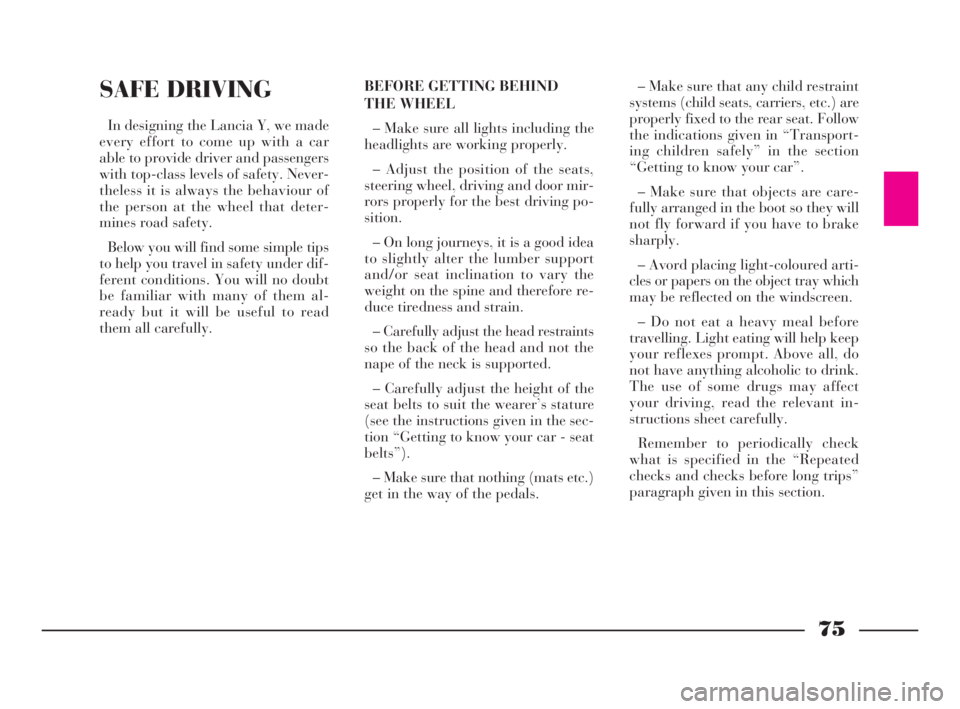
75
G
SAFE DRIVING
In designing the Lancia Y, we made
every effort to come up with a car
able to provide driver and passengers
with top-class levels of safety. Never-
theless it is always the behaviour of
the person at the wheel that deter-
mines road safety.
Below you will find some simple tips
to help you travel in safety under dif-
ferent conditions. You will no doubt
be familiar with many of them al-
ready but it will be useful to read
them all carefully.BEFORE GETTING BEHIND
THE WHEEL
– Make sure all lights including the
headlights are working properly.
– Adjust the position of the seats,
steering wheel, driving and door mir-
rors properly for the best driving po-
sition.
– On long journeys, it is a good idea
to slightly alter the lumber support
and/or seat inclination to vary the
weight on the spine and therefore re-
duce tiredness and strain.
– Carefully adjust the head restraints
so the back of the head and not the
nape of the neck is supported.
– Carefully adjust the height of the
seat belts to suit the wearer’s stature
(see the instructions given in the sec-
tion “Getting to know your car - seat
belts”).
– Make sure that nothing (mats etc.)
get in the way of the pedals.– Make sure that any child restraint
systems (child seats, carriers, etc.) are
properly fixed to the rear seat. Follow
the indications given in “Transport-
ing children safely” in the section
“Getting to know your car”.
– Make sure that objects are care-
fully arranged in the boot so they will
not fly forward if you have to brake
sharply.
– Avord placing light-coloured arti-
cles or papers on the object tray which
may be reflected on the windscreen.
– Do not eat a heavy meal before
travelling. Light eating will help keep
your reflexes prompt. Above all, do
not have anything alcoholic to drink.
The use of some drugs may affect
your driving, read the relevant in-
structions sheet carefully.
Remember to periodically check
what is specified in the “Repeated
checks and checks before long trips”
paragraph given in this section.
4C068-089 ING 11-03-2008 11:59 Pagina 75